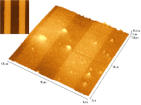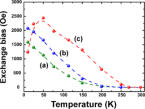
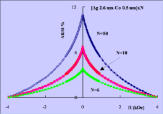


Multilayer Group



Tuning the perpendicular magnetic anisotropy of CoCr layers in multilayered systems
The
combination
of
Pt
with
Co
either
in
alloy
or
in
multilayer
form
is
widely
studied
among
the
potential
magnetic
media
for
ultrahigh
density
magnetic
recording.
On
the
other
hand
the
combination
of
Co
with
Cr
in
alloy
form
is
currently
providing
commercial
magnetic
media.
In
an
effort
to
further
exploit
and
benefit
from
both
systems,
we
fabricated
Co
1-x
Cr
x
/Pt
multilayers
with
two
adjustable
parameters.
The
first
one
is
the
Cr
concentration
on
CoCr
layer
(x
=
0,
0.05,
0.30),
which
modulates
segregation
effects
on
Co
grains,
thus
tunes
macroscopic
magnetic
features
such
as
saturation
magnetization
and
coercive
field.
The
second
one
is
the
small
layer
thickness
(<6
nm)
that
affects
interlayer
coupling, perpendicular magnetic anisotropy and magnetization enhancement through spin polarization of Pt atoms in a ferromagnetic environment.
The effect of composition and structural ordering on the magnetism of FePt nanoparticles
Spherical
(4
nm)
FePt
nanoparticles
were
synthesized
by
the
simultaneous
decomposition
of
Fe(CO)
5
and
the
polyol
reduction
of
Pt(acac)
2
.
The
final
Fe-to-Pt
composition
was
tuned
between
15-55
at.%
by
varying
the
ingredient
precursor
ratios.
Structural
ordering
is
promoted
in
all
cases,
though
samples
approximating
equiatomic
Fe/Pt
ratios
eventually
transform
to
fct-FePt
phase
while
the
FePt
3
-phase
is
favored
for
the
Pt-richer
samples.
Consequently,
the
magnetic
features
of
the
annealed
nanoparticles
may
be
categorized;
the
hard
magnetic
FePt
region
dominating
for
Fe
content
between
40-55
at.%
and
the
soft
magnetic
FePt
3
region
dominating
in
the
region
20-30
at.%
while
Fe
content less than 20 at.% results in Pt-richer phases with diminishing ferromagnetic behavior.

Pt-Co Multilayers: Interface Effects at the Monolayer Limit
This
project
focuses
on
the
structural,
magnetic
and
spectroscopic
magneto-optical
features
of
Pt-Co
multilayers
prepared
by
e-beam
evaporation.
In
order
to
examine
interface
and
induce
magnetism
effects,
the
layer
thickness
was
always
kept
under
4
monolayers
in
order
to
form
a
hybrid
structure
between
alloys
and
the
conventional
multilayers.
X-ray
diffraction
spectra
revealed
the
multilayer
nature
of
the
samples
while
magnetometry
measurements
recorded
tunable
perpendicular
magnetic
anisotropy
and
enhanced
magnetization
values
due
to
the
high
degree
of
Pt-
polarization
in
a
ferromagnetic
environment.
The
experimental
technique
that
allows
one
to
study
the
small
induced
magnetism
is
the
X-ray
magnetic
circular
dichroism
(XMCD)
which
provides
quantitative
information
on
spin
and
orbital
magnetic
moments
of
the
absorbing
atom
in
both
amplitude
and
direction.
XMCD
experiments
were
performed
at
ESRF
on
the
ID12
beamline
at
Pt
L
2,3
-edges where enhanced Pt contribution on the perpendicular anisotropy was evidenced.
Critical radius for exchange bias in naturally oxidized Fe nanoparticles
Monodisperse
Fe
nanoparticles
prepared
by
thermal
decomposition
of
iron
pentacarbonyl
in
the
presence
of
oleic
acid
were
readily
oxidized
on
exposure
to
air.
The
resulting
nanocrystals
have
been
identified
as
inverse
spinels,
with
the
γ-Fe
2
O
3
as
the
dominant
phase
of
the
small
5
nm
iron
oxide
nanocrystals,
while
the
proportion
of
the
Fe
3
O
4
component
gradually
increases
on
increasing
the
particle
size.
The
small
particles
volume
resulted
in
finite
size
effects
i.e.
the
magnetization
deviates
from
the
T
3/2
Bloch's
law.
High
field
irreversibility
and
shifted
hysteresis
loops
after
field
cooled
processes
have
been
detected,
and
attributed
to
a
low
temperature
surface
spin-glass
layer.
Moreover,
there
is a critical diameter, below which the surface spin-glass behavior and exchange bias effect abruptly disappear.



Layer-resolved magnetic moments in Ni/Pt multilayers
The
magnetic
moments
in
NiPt
multilayers
are
thoroughly
studied
by
combining
experimental
and
ab
initio
theoretical
techniques.
SQUID
magnetometry
probes
the
samples'
magnetizations.
X-ray
magnetic
circular
dichroism
separates
the
contribution
of
Ni
and
Pt
and
provides
a
layer-resolved
magnetic
moment
profile
for
the
whole
system.
The
results
are
compared
to
band-structure
calculations.
Induced
Pt
magnetic
moments
localized
mostly
at
the
interface
are
revealed.
No
magnetically
"dead"
Ni
layers
are
found.
The magnetization per Ni volume is slightly enhanced compared to bulk NiPt alloys.
Ag/Co multilayers: From film growth to GMR sensor
The
Ag-Co
system
either
in
multilayer
or
in
granular
alloy
form
exhibits
the
GMR
(Giant
MagnetoResistance)
effect.
By
adjusting
the
modulation
parameters
an
intermediate
structure
may
be
formed
offering
new
possibilities
for
magnetoelectronic
applications.
This
structure
resides
in
the
limit
between
multilayers
and
granular
alloys
and
is
called
granular
multilayer.
The
dependence
of
GMR
values
on
the
individual
layer
thickness
and
on
the
total
film
thickness
was
parameterised
and
magnetoresistance
values
of
16%
at
300
K
and
36%
at
30
K
were
achieved.
The
outcome
of
this
study
is
the
fabrication
of
a
two-dimension
magnetic
field
sensor
consisting
of
8
specific
elements
forming
a
2x4
array.
The
sensor
is
specialized
in
small
magnetic
field
regions
while
its
response
was
found
quite
satisfactory
regarding
its
uniformity
and
repeatability.
The
sensor
may
be
upgraded to larger arrays and to three dimensions in order to fulfill various market needs.

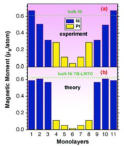
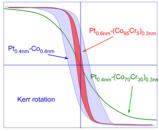
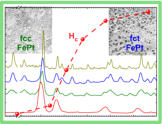
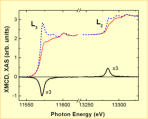




Application of magnetic nanoparticles as magnetic hyperthermia agents
In
this
project
we
study
the
heating
efficiency
of
magnetic
nanoparticles
and
their
application
for
magnetic
hyperthermia
on
cancer
cells.
Different
human
breast
cancer
cell
lines
were
used
to
assess
the
suitability
of
nanoparticles
for
in
vivo
application.
The
experiments
revealed
a
very
good
cytotoxicity
profile
and
significant
uptake
efficiency
together
with
relatively high specific absorption rates and fast thermal response, features that are crucial for adequate thermal efficiency and minimum duration of treatment.






Morphology influence on nanoscale magnetism of Co nanoparticles
Co-based
nanostructures
ranging
from
core/shell
to
hollow
nanoparticles
were
prepared
by
varying
the
reaction
time
and
the
chemical
environment
during
the
thermal
decomposition
of
Co
2
(CO)
8
.
Both
structural
characterization
and
kinetic
model
simulation
illustrate
that
the
diffusivities
of
cobalt
and
oxygen
determine
the
growth
ratio
and
the
final
morphology
of
the
nanoparticles.
Exchange
coupling
between
Co
and
Co-oxide
in
core/shell
nanoparticles
induced
a
shift
of
field-cooled
hysteresis
loops
that
is
proportional
to
the
shellhickness, as verified by numerical studies.




Research of novel magnetic materials with desirable technological features
The
study
of
magnetic
heterogeneous
systems
whose
properties
are
defined
on
a
nanometer
scale
has
become
one
of
the
most
promising
directions
in
materials
science.
Recent
development
of
lithographic
techniques
as
well
as
improved
chemical
synthesis
methods
allows
researchers
to
engineer
novel
nanostructured
materials
consisting
of
arrays
of
plots,
self-organized
nanocrystals
and
multilayers
grown
as
patterns
on
different
substrates.
The
present
paper
proposes
the
combination
of
self–assembly
techniques
with
the
use
of patterned substrates in an effort to manipulate the local arrangement of the nanoparticles and produce well defined large-scale arrays of magnetic nanoentities.
